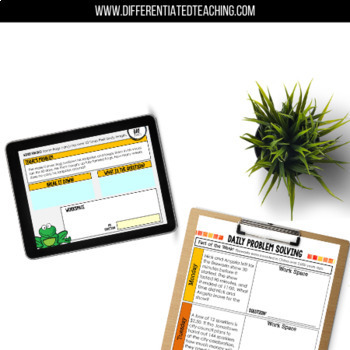2nd Grade Problem of the Day: Daily Math Word Problem Practice for MARCH
- Zip
- Google Apps™

Products in this Bundle (2)
Description
Engage and challenge your second grade students with this hybrid 2nd Grade Problem of the Day: Spring & St.Patrick's Day Math Word Problem resource for March. Packed with engaging and relevant math story problems, this resource is perfect for daily problem solving practice. Each problem of the day is specifically designed for second graders, addressing essential math skills while integrating the excitement of March holidays and events.
Your students will become skilled mathematicians as they analyze and solve these stimulating story problems, promoting critical thinking and mathematical fluency. With a month's worth of intriguing and diverse word problems, you can give your students ample opportunities to strengthen their math proficiency.
This print & digital resource is invaluable for any 2nd grade teacher looking to inspire a love for math and build strong problem-solving abilities in their students.
This 2nd Grade Word Problem of the Day Pack includes:
✔ Daily Problem Solving Teacher's Guide
✔ 5 weeks of March word problems
- 25 problems on Google Slides
- 5 themed weekly paper-saving printables with daily word problems
✔ 2 versions of paper-based student response sheets & workspace
✔ Answer keys
✔ Access to step-by-step directions for assigning these in Google Classroom
Word Problem Themes:
Each week includes a fun fact & the word problems are themed to align with monthly holidays, special events, and kid-friendly topics. This month's topics are:
- Week 1: Reading
- Week 2: Pi Day
- Week 3: St. Patrick's Day
- Week 4: Spring
- Week 5: Space
Get the 12-month bundle here:
2nd Grade Daily Problem Solving (Print + Digital Bundle)
Please note: These are challenging 2nd grade word problems. You'll likely want to complete these problems as part of guided practice activity. Initially, you may see students relying on drawing pictures or using inefficient problem-solving strategies. Encourage them to break down complex problems and explore multiple solution methods. These challenging problems foster a growth mindset and the skills needed for future academic success.
If you view the preview and feel this may be discouraging for your learners, feel free to check out the first grade version here: 1st Grade Daily Problem Solving
-----------------------------------------------------------------------------------------
The Benefits of Using a Math Word Problem of the Day
❑ Daily practice builds routine and structure for practice
❑ Less overwhelming to reluctant or struggling learners
❑ Helps identify students who may need additional support
❑ Encourages discussion about skills & strategies
Ways to incorporate these story problems into your math routine:
• Daily warm-ups or math center during summer school
• Whole or small group math instruction
• Test prep
• Independent enrichment or early finisher challenge
Here's what others have to say about Daily Problem Solving...
♥ AMAZING RESOURCE! I have my kiddos do daily math each week but wanted to incorporate more word problems. I staple this each week to their original daily math page. The problems are diverse and challenging. I love how many skills are covered and how they are multi-step. Perfect!! - Samantha M.
♥ I absolutely LOVE this product! I cannot say enough good things about it. It is rigorous and covers so many of our critical standards. I start each math lesson with this as a warm-up. As the students come in for math they get started on it and then we go over it together. I like that it has a reflection at the end so my kids think about what skills they have mastered and which ones they still need to work on. I like the monthly theme with the little fact. So fun! -Rebecca R.
-------------------------------------------------------------------------------------------
More Math Word Problem Resources in the Daily Problem Solving Line…
- 1st Grade Daily Problem Solving
- 3rd Grade Daily Problem Solving
- 4th Grade Daily Problem Solving
- 5th Grade Daily Problem Solving
- 6th Grade Daily Problem Solving
- 7th Grade Daily Problem Solving
- 8th Grade Daily Problem Solving
Terms of Use:
© 2020 Rebecca Davies. All rights reserved by the author. These materials are intended for personal use by a single classroom only. Copying for more than one teacher, classroom, department, school, or school system is prohibited. For use in multiple classrooms, please purchase additional licenses. This product may not be distributed or displayed digitally for public view. Failure to comply is a copyright infringement and a violation of the Digital Millennium Copyright Act (DMCA). Clipart and elements found in this PDF are copyrighted and cannot be extracted or used outside this file without permission or license. See product file for clip art and font credits.





